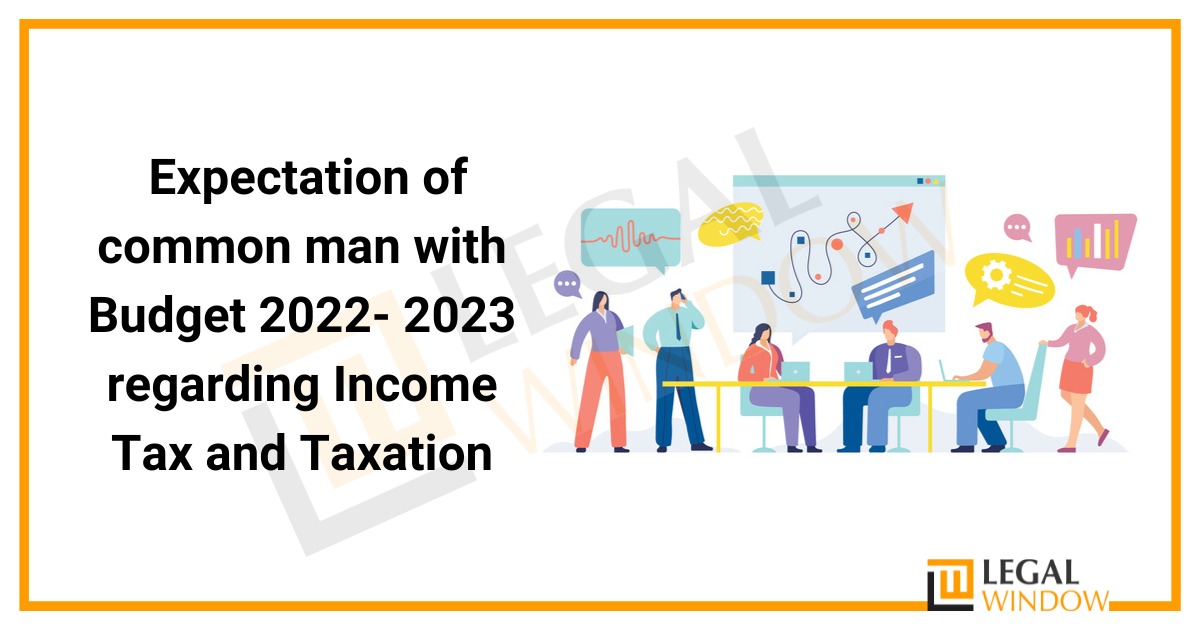Expectation of common man with Budget 2022- 2023 regarding Income Tax and Taxation
- February 1, 2023
- Latest News

Before the annual Budget announcement, pictures of India’s finance ministers entering parliament while carrying briefcases circulated for years. All of that changed in 2019 when Nirmala Sitharaman, the finance minister, switched in her budget briefcase for a “Bahi Khata”. Prior to the 2019 Budget presentation, Nirmala Sitharaman was spotted holding a red “Bahi Khata”, a traditional book of accounts. The choice to replace the briefcase with a “Bahi Khata” was interpreted as a rejection of the colonial past.
On the other hand, Sitharaman’s choice to employ the Bahi Khata gave the Budgetary exercise an Indian flair. In India, householders and business owners have utilized the Bahi Khata for years to keep track of their finances. In 2020, the customary carrier of Budget documents made an appearance for the second and final time. However, a more contemporary tool replaced this conventional book of accounts the next year. Using an Indian-made tablet, Nirmala Sitharaman delivered the budget in 2021 without using any paper. In 2021 and again in 2022, she took the tablet to parliament in a red Bahi Khata-style bag. It was assumed that using a tablet would support the government’s Digital India initiative.
This article briefly describes the Budget 2023 Expectations Updates, & What could a common man expect from Budget 2022-2023 in terms of Tax?
| Table of Content |
A short introduction about Budget and Way Forward
The Indian government’s annual budget, which includes information on all expenditures, income projections, and development objectives, is a crucial document. The Indian Finance Minister presents the budget to Parliament each year, which serves as the foundation for distributing funds for the nation’s economic and social welfare. Every year, the budget also provides information about plans, actions, and steps taken to strengthen the nation’s current fiscal and economic foundations.
In this write-up we’ll try to figure out the expected characteristic of Budget 2022- 2023 specifically for the Taxation and expected relief for taxation for the citizens of country.
The citizen of India, should keep in mind that budget is important for the economic growth of India. Since, it is so crucial for India, so let us try to give a shot in expecting what could be the particulars that may present in Indian Budget.
Expected Constituents of Union Budget for 2022-23
The budget for 2022-23 seemed to be a basic, clear budget that did not delve into any intricate tax reform and instead appeared to focus on raising government expenditure to encourage investment and economic development. However, there are significant inconsistencies in the budget that should be highlighted.
The budget aims for FY2022-23 are intended to support India’s aspirations in the Amrit Kaal as it approaches the centennial of independence.
- Concentrate on development and overall well-being.
- Assistance with technological development, energy transformation, and climate action
- A fair cycle that begins with private investment and ends with public capital investment.
This year, the Union Budget for Fiscal Year 2022-2023 seeks to develop infrastructure by concentrating on four priorities:
- Prime Minister GatiShakti
- Development that includes everyone
- Productivity and investment, new possibilities, energy transition, and climate action are all on the agenda.
- Finance for investment
Government Budget Objectives 2022-2023
The government budget has the following goals:
- Resource Redistribution: The government uses fiscal policy to redistribute resources in accordance with the country’s economic (profit maximisation) and social (public welfare) interests.
- Subsidies or Tax Credits: To promote investment, the government might offer tax cuts, subsidies, and other incentives to manufacturers. For example, by high taxes, the government discourages the manufacturing of dangerous consumer goods (such as whisky, cigarettes, and so on) and encourages the use of “khaki products” through subsidies.
- Producing Goods and Services Directly: If the private sector is unwilling to participate, the government can take over production directly.
- Reducing Income and Wealth Disparities: Economic disparity is critical in every economy. Through fiscal policy, the government hopes to eliminate income and wealth disparities. Income is distributed by taxing the wealthy and spending more on the welfare of the poor. It will reduce income inequality by lowering the earnings of the wealthy and raising the living standards of the poor.
- Stability in the Economy: To attain the aim of economic stability, the government budget works to prevent business swings of inflation or deflation. The government’s fiscal policy aims to regulate the various stages of business volatility.
- Administration of Public Enterprises: There are several public sector enterprises (particularly natural monopolies) that are founded and managed for the public’s social benefit. The budget is being developed in order to establish various mechanisms for managing these companies and giving financial help.
- Economic Development: The rate of growth of a country is determined by the pace of savings and investment. Budgetary policy focuses on generating adequate resources for public-sector investment to that purpose. As a result, the government creates different budgetary measures to boost the total rate of savings and investment in the economy.
- Reducing Regional Disparities: The government budget’s purpose is to eliminate regional disparities through tax and expenditure measures that encourage the construction of manufacturing units in economically depressed areas.
What could common man expect from Budget 2022-2023 in terms of Income Tax?
The Union Budget 2023, which will be announced on February 1, 2023, is only a few minutes away. The Prime Minister Narendra Modi’s 11th consecutive budget and Finance Minister Nirmala Sitharaman’s fifth consecutive budget will be released in 2023. In order to increase demand, create employment, and set the economy on a course of sustained development, the Budget is expected to address important concerns related to the high levels of inflation and expectation of common man could be determine as follows:
Amendments to Tax Rates and Tax Slabs
The existing income tax laws stipulate that a person must pay taxes depending on slab rates. In India, the maximum slab rate for income surpassing 5 crore rupees (after surcharge and cess) is now 42.744%, which is quite high when compared to other Asian nations (Hong Kong – 17%, Singapore – 22%, Malaysia – 30%).
Furthermore, despite a new tax system being implemented in Budget 2020, the rate of taxation for people has not altered since the fiscal year (FY) 2017–18. (in which one could opt for lower slab rates if they forego various deductions and exemptions). The streamlined system hasn’t, however, produced the anticipated results for people’s wallets.
Therefore, policymakers could consider raising the threshold for the highest tax rate from 10 lakh to 20 lakh in order to provide the aam aadmi a break under the previous regime.
Similar to this, under the simplified tax system, the income tax rate might be lowered to 25% for income surpassing $20,000 and 20% for income slabs between $10,000 and $20,000. As a result, the new system will be more appealing than the previous one. The anticipated maximum slab rate under the simplified system would consequently be decreased to 35.62% (including surcharge and cess).
Tax reductions through Deductions from Income
There have long been plans to raise the section 80C exemption threshold for tax-saving investments to at least 2.5 lakhs. Since FY 2014–15, the current ceiling of Rs. 1.5 lakhs has stayed the same, which seems to be fairly low. The government should consider raising the cap under Section 80C in light of the rising cost of living and inflation.
This will have two benefits: individual taxpayers will be more likely to save more and benefit from decreased tax outlays, improving aggregate buying power.
Currently, Section 80C provides a deduction for tuition paid to any university, college, school, or other educational institution in India for up to two children. However, because this falls under the aggregate limit of 1.5 lakh, the deduction is not fully used.
With the expense of education fast approaching historic heights, it is critical that the deduction be separated as a distinct deduction, akin to medical insurance. As a result, the government may consider creating a separate section to allow for a deduction for educational costs.
Furthermore, given the rise in the cost of medical treatments, the cost of comprehensive insurance has skyrocketed, and the previous restriction of 25,000 (50,000 for senior people) under this provision may be reconsidered. The cap might be raised to $50,000 (or $100,000 for elderly citizens). Furthermore, paid persons are unlikely to retain their whole earnings in a savings bank account, which offers a far lower rate of return than term deposits. They may shift some of their funds to term/recurring deposits in banks to receive higher rates. As a result, interest on all sorts of bank deposits (for example, FDRs) may fall under the purview of section 80TTA. Furthermore, the limit might be raised from 10,000 to 50,000.
Aside from the financial expectations mentioned above, the government may consider issuing specific guidance/policy-related features on work from home. Following the epidemic, significant changes occurred in organisational culture.
Work from home, remote working, hybrid working, and other initiatives have been implemented by organisations. However, due to the new remote work culture, there are no regulations or guidelines in place for many aspects (such as taxation, social security, insurance, and worker compensation).
Takeaway
These are some of the distinctive items in the Indian government budget that are targeted at resolving the economy’s shortcomings and hastening its recovery in the present economic environment. These steps will surely improve the country’s prospects for economic recovery and growth, and they should thus be implemented as soon as possible.
As we all wait for Budget 2023, we hope that the expectations of individual taxpayers are satisfied, and that the Indian economy grows as a result.
Great, so far we have addressed all of the predicted details that we may see in the Government Budget for 2022-2023, but if you have any additional questions, don’t hesitate to contact us. You can connect with us at Legal Window.
LegalWindow.in is a professional technology driven platform of multidisciplined experts like CA/CS/Lawyers spanning with an aim to provide concrete solution to individuals, start-ups and other business organisation by maximising their growth at an affordable cost. Our team offers expertise solutions in various fields that include Corporate Laws, Direct Taxations, GST Matters, IP Registrations and other Legal Affairs.
Categories
- Agreement Drafting (23)
- Annual Compliance (11)
- Change in Business (36)
- Company Law (148)
- Compliance (90)
- Digital Banking (3)
- Drug License (3)
- FEMA (17)
- Finance Company (42)
- Foreign Taxation (6)
- FSSAI License/Registration (14)
- GST (118)
- Hallmark Registration (1)
- Income Tax (200)
- Latest News (34)
- Miscellaneous (164)
- NBFC Registration (8)
- NGO (14)
- SEBI Registration (6)
- Section 8 Company (7)
- Start and manage a business (21)
- Startup/ Registration (128)
- Trademark Registration/IPR (40)
Recent Posts
- Post incorporation compliances for companies in India April 30, 2024
- Startup’s Guide to Employee Stock Ownership Plans April 29, 2024
- Master Secretarial Audit: A Complete Compliance Guide April 27, 2024
About us
LegalWindow.in is a professional technology driven platform of multidisciplined experts like CA/CS/Lawyers spanning with an aim to provide concrete solution to individuals, start-ups and other business organisation by maximising their growth at an affordable cost.








